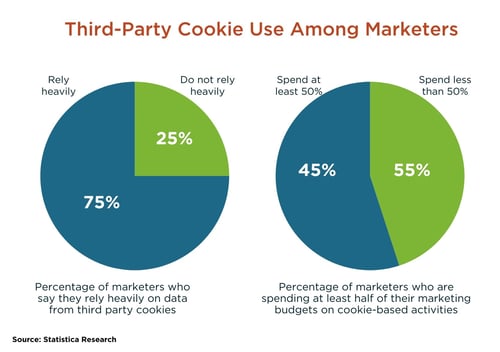Phasing-Out of Third-Party Cookies: Insights From Marketing Technology Expert Alex Moore

I’ve been following the third-party cookie news headlines for what seems to be a long time. However, all the updates over the years have had little consequence—until recently.
At the beginning of January 2024, Google launched its first wave of phasing out third-party cookies by default to 1% of its global users. Now I’m wide awake and attentive, and you should be too — but why? And, why now?
I sat down with Stratagon co-founder and marketing technology expert, Alex Moore, to discuss the positives and negatives of this change, and what it means for marketers, business leaders, and consumers. The following are some of the key takeaways from our conversation.
Key Takeaway 1: There’s a Reason for the Hype
When the business world started adjusting their data privacy practices to meet GDPR requirements, many in the marketing world began to give serious thought that there could come a day when the importance of data privacy would have an impact on the use of third-party cookies.
In 2019 Firefox phased out third-party cookies. Safari followed suit in 2020. However, these companies haven’t been given too much attention by brands because they don’t hold much of the market share.
Google Chrome commands the desktop and mobile market, making it the most popular browser. As for search engines, again Google dominates the market with almost 97% market share of mobile and 86% of desktop (source: Statista).
.jpg?width=503&height=355&name=Browser%20Market%20Share%20(1).jpg)
This data puts into perspective the significant influence Google has over the user experience and why many brands didn’t take significant measures in their marketing when Safari and Firefox announced the phasing out of third-party cookie data on their browsers.
According to data collected in late 2022 and published by the Statista Research Department in March 2023, 75% of marketers rely heavily on third-party cookies and 45% of marketers are spending at least half their budgets on campaigns and other activations based on third-party cookies.

While many brands have adjusted some of their strategy to fit the phasing out of third-party cookies, the truth is that many marketers still rely on and use third-party cookies.
Key Takeaway 2: The World Is Not Going to End
Yes, third-party cookies are going away as we knew them in the past, but the world is not coming to an end. Alex shared, “We have the ability to navigate this space. I believe that as a result of them going away, it will drive innovation. We have other targeting options today, and other solutions that are evolving and will continue to evolve so that businesses and marketers can still reach audiences.”
It is important to note here that users will still have the ability to opt-in to third-party cookies. What is changing is that their settings will no longer automatically default to accepting third-party cookies.
Key Takeaway 3: Increased Costs
Alex shared further insight into the potential for increased costs for both businesses and consumers.
“While we advocate for consumer privacy, we also recognize the value of personalized advertising. There are consequences to the phasing out of third-party cookies by default. The precision we once had in targeting will diminish, leading to a less efficient use of marketing resources.
Business leaders should anticipate higher costs to achieve the same marketing outcomes that they once had with third-party cookies.
There will need to be a strategic overhaul in how marketers and business leaders approach and measure our marketing efforts. With less precision, the ad spend will be used to reach a less targeted audience, thereby causing a decrease in Return on Ad Spend (ROAS) and an increase in Customer Acquisition Cost (CAC).
It is fair to project that consumers may experience an increase in price for certain goods and services to offset the costs of advertising to less targeted audiences. This may particularly be the case in B2C markets.”
Key Takeaway 4: Increased Potential for A Less Than Ideal User Experience
Another aspect to consider is the delicate balance between personalization and privacy. Most consumers are not aware of the extent to which third-party cookies currently improve their online experience.
Moore shared, “The phase-out of cookies will also have significant implications for the user experience. Not being able to reach a specific target audience means that consumers might encounter less relevant advertising.
This necessitates a delicate balance in crafting marketing messages: they must be broad enough to encompass a wider audience yet specific enough to maintain relevance. As marketers, our goal should always be to enhance the consumer experience, not detract from it.
Again, there is a delicate balance between personalization and privacy. Consumers will still have the option to opt into third-party cookies, allowing for a more tailored online experience. Their choices will reflect a broader trend where user preference plays a pivotal role in shaping the advertising landscape.”
Key Takeaway 5: There Are Other Strategies Available to Drive a Better, More Personalized User Experience
There are several digital marketing strategies that we can use now to reach our target audience that don’t require the use of third-party data.
For instance, advertising on specific publications can provide a level of targeting that aligns with our audience's interests and behaviors. Contextual signals, such as the type of content consumed by the user, offer powerful cues for effective targeting.
“Contextualized Marketing is already used by many companies and will continue to grow. It uses contextual signals to help place ads or content to relevant audiences. There are several solutions within the realm of contextualized marketing available today.
Programmatic advertising uses contextual signals such as the type of content consumed by the user to reach a very specified audience. Using an account-based marketing platform such as BrandGen.io allows brands to reach an even more specified targeted audience without the use of third-party data.
Think of it like this, you are a company that would like to place ads in front of a particular target audience. Now, think about the online publications they read and interact with. Online publications bring a lot of context such as persona, industry, or vertical. These platforms also can use additional data overlays in addition to that context to help sharpen the messaging even a little bit more.
Now, add IP targeting into the same scenario to match the IP with the publication and specify that the ad only be shown to particular accounts. Now you’ve created a highly targeted audience who will be more receptive to your message, products, and services.
Google Topics, a form of contextualized marketing, protects users’ information while allowing advertisers to continue promoting relevant content to people interested in topics that correlate to what they offer.
Using identity solutions is another strategy as many identity solution companies are building their own proprietary identity grafts that create a pseudonymous and reliable consumer identifier that advertisers may use to measure online consumer behavior and seek targeted advertising.
Most marketers are already using first-party data to better enhance the user experience. Moving forward they will find ways to get more actionable insights using first-party data, even through channels such as email. Using priority send or intelligent sending technology, such as Seventh Sense will be key in ensuring that personalization crosses all the touchpoints consumers encounter with a brand.
These strategies allow us to narrow down our focus to specific industries or companies, reducing the spillover effect of broad targeting. The use of first-party data within platforms like Meta and LinkedIn also offers robust avenues for precise targeting, relying on the rich data profiles of users on these platforms.”
Key Take Away 6: The Impact of These Changes Will Unfold Gradually
As we navigate this transition, it's crucial to understand that the full impact of these changes will unfold gradually. “The metrics we've relied upon—like conversion rates and click-through rates—might shift, necessitating a reevaluation of our success indicators. Marketers need to be agile, ready to adapt strategies based on emerging trends and data.”
The Road Ahead
The phase-out of third-party cookies is not just a challenge; it's an opportunity to innovate and redefine digital marketing. By embracing new strategies and technologies, focusing on contextual relevance, and balancing privacy with personalization, we can navigate this new era effectively.
The digital marketing world is evolving, and staying ahead requires both adaptability and foresight.
As we move forward, it's essential to keep an eye on these developments, constantly refining our approaches to align with the changing dynamics of digital advertising. The future of marketing is not set in stone; it's being written now, and we have a significant role in shaping it.
